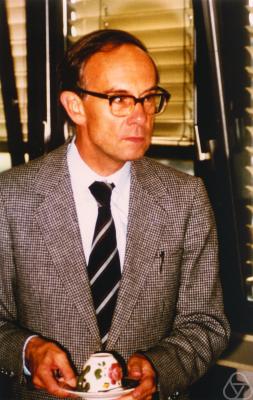Friedrich Hirzebruch facts for kids
Quick facts for kids
Friedrich Hirzebruch
|
|
|---|---|

Hirzebruch in 1980 (picture courtesy MFO)
|
|
| Born |
Friedrich Ernst Peter Hirzebruch
17 October 1927 Hamm, Province of Westphalia, Germany
|
| Died | 27 May 2012 (aged 84) Bonn, Germany
|
| Alma mater |
|
| Known for |
|
| Awards |
|
| Scientific career | |
| Fields | Mathematics |
| Institutions |
|
| Doctoral advisor |
|
| Doctoral students |
|
Friedrich Ernst Peter Hirzebruch (born October 17, 1927 – died May 27, 2012) was a very important German mathematician. He worked on topics like topology, complex manifolds, and algebraic geometry. Many people called him "the most important mathematician in Germany after World War II."
Contents
Early Life and Education
Friedrich Hirzebruch was born in Hamm, Germany, in 1927. His father was also a math teacher. Friedrich studied mathematics at the University of Münster from 1945 to 1950. He also spent a year studying at ETH Zürich in Switzerland.
In March 1945, near the end of World War II, Hirzebruch became a soldier. He was captured by British forces. A British soldier found out he was studying math. The soldier then drove him home and told him to keep studying.
Career in Mathematics
After finishing his studies, Hirzebruch worked at the University of Erlangen-Nuremberg. Then, from 1952 to 1954, he worked at the Institute for Advanced Study in Princeton, New Jersey, USA. He also spent a year at Princeton University.
In 1956, he became a professor at the University of Bonn in Germany. He stayed there for the rest of his career. In 1981, he became the director of the Max-Planck-Institut für Mathematik (Max Planck Institute for Mathematics). This institute is a famous place for math research.
Important Discoveries
Hirzebruch made many big contributions to mathematics. One of his most famous works is the Hirzebruch–Riemann–Roch theorem (from 1954). This theorem was a major step forward in understanding complex manifolds. It also helped lead to other important theorems like the Atiyah–Singer index theorem.
He wrote a very important book called Neue topologische Methoden in der algebraischen Geometrie (New Topological Methods in Algebraic Geometry) in 1956. This book helped introduce new ways of thinking about complex algebraic geometry.
Hirzebruch also worked with other famous mathematicians. He wrote important papers on topological K-theory with Michael Atiyah. He also worked with Armand Borel on characteristic classes. In his later work, he studied Hilbert modular surfaces with Don Zagier. He even found surprising connections between different areas of math, like number theory and differential topology.
His work greatly influenced many top mathematicians. These include Kunihiko Kodaira, John Milnor, Armand Borel, Michael Atiyah, Raoul Bott, and Jean-Pierre Serre.
Mentoring and Leadership
Friedrich Hirzebruch was also a great leader in the math community. He supervised the doctoral studies of 52 mathematicians. Some of his students include Egbert Brieskorn, Matthias Kreck, and Don Zagier.
He is well-known for starting the Mathematische Arbeitstagung (Mathematical Working Meetings) at Bonn University in 1957. These meetings brought together mathematicians from all over the world. Famous mathematicians like Michael Atiyah and Alexander Grothendieck were among the first speakers. These meetings helped math research grow in areas like topology, geometry, and number theory.
In 1980, he founded the Max Planck Institute for Mathematics in Bonn. He was its director until 1995. The Arbeitstagung meetings are now held at this institute.
Hirzebruch was also the president of the German Mathematical Society twice. He also served as the first President of the European Mathematical Society from 1990 to 1994. He played a big role in rebuilding mathematical connections in Germany and Europe after the war.
He passed away on May 27, 2012, at the age of 84.
Awards and Recognition
Friedrich Hirzebruch received many awards for his amazing work.
- He won the Wolf Prize in Mathematics in 1988.
- He was awarded the Lobachevsky Medal in 1989.
- In 1996, the government of Japan gave him the Order of the Sacred Treasure.
- He received the Einstein Medal in 1999.
- He won the Cantor medal in 2004.
He was also a member of many important science groups around the world. These include the United States National Academy of Sciences, the Royal Society in the UK, and the French Academy of Sciences.
See also
 In Spanish: Friedrich Hirzebruch para niños
In Spanish: Friedrich Hirzebruch para niños

